
News |
- Lake St. Martin 'Channel' to Lake Winnipeg To Close
- Bipole III Hearings To Be Adjourned?
- US Election Results Give Environmentalists Hope
- Canadian Environment Leader Honoured
- Sandy
- British Columbia Earthquake and Tsunami
- Another Omnibus Budget Bill Weakens The Environment
- Bipole III Hearings Resume in Winnipeg October 29
- Long Overdue Canada's Boreal Caribou Strategy Released
- Released : Marine Protected Area Guidelines North America
- Thousands Defend Coast from Pipelines
- CEC Bipole III Hearings Continue Travels
| Lake St. Martin 'Channel' to Lake Winnipeg To Close | 9 November 12 |
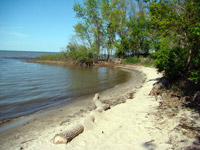
Most of the communities near Lake St. Martin were evacuated due to high waters, damage, and lack of access. Many of these families and businesses are still evacuated. The decision to drain water through the Channel was made based on destruction of 800 homes, cottages and businesses on Lake Manitoba. The Channel was an engineering feat that cost $ 100 million and constructed 'to drain water from Lake St. Martin through the new channel to the Dauphin River and into Lake Winnipeg'. To date there appears to be no intention to file an environmental plan regarding the closure, or to put species monitoring in place after the closure. Concern about the impact on the fishery in Lake St. Martin has not resulted in any assessment to date. View November 7, 2012 Manitoba Government Media BulletinView July 2011 AECOM & KGS Group report View December 30, 2011 Manitoba Wildlands news item View November 4, 2011 Manitoba Wildlands news item View July 27, 2011 Manitoba Wildlands news item View July 26, 2011 Manitoba Government Media Bulletin View Aug 23, 2011 The First Perspective article View Manitoba Wildlands Water Projects page |
|
 Print version Print version |
Top |
| Bipole III Hearings To Be Adjourned? | 9 November 12 |
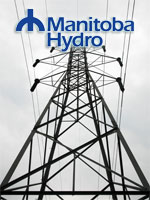
Bipole III, estimated cost $3.28 billion including converter stations, would run down the west side of the province to bring more reliability to Hydro's system, and enable future hydro electric developments such as Keeyask and Conawapa. Manitoba Hydro announced alterations to the proposed route to avoid fragile caribou and moose habitat on October 23, 2012 in response to concerns raised by Manitoba Conservation and Water Stewardship Environmental Approvals Branch. The route changes were announced nearly one-month into CEC hearings, and without updates to the December 2011 environmental impact statement or supplemental materials. "This is not Etch-a-Sketch transmission routing. There needs to be an environmental assessment based upon the route that is before the commission. It's plain and simple," Manitoba Metis Federation (MMF) lawyer Jason Madden told the CEC November 6, 2012. "I believe it is necessary for Manitoba Hydro to prepare a written supplemental report to its environmental impact statement, in which it outlines the environmental effects of the route changes in sufficient detail for the identified effects to be considered by the CEC, as well as any affected parties and registered participants in the current public review process," wrote Tracey Braun, Director of Manitoba Conservation and Water Stewardship Environmental Approvals Branch in a November 9, 2012 letter to Manitoba Hydro, the CEC, and all participants in the current CEC hearings. "It is my submission that the appropriate way to deal with this mess is to simply adjourn the hearing process until such time as Hydro has got its act together," Peguis First Nation lawyer Robert Dawson told the CEC panel November 6, 2012. The CEC has not yet announced an adjournment, and hearings are scheduled to resume in Winnipeg at 9am on Tuesday November 13, 2012 at the Winnipeg Convention Centre. View November 9, 2012 Winnipeg Free Press coverageView November 9, 2012 Tracey Braun, Director of Manitoba Conservation and Water Stewardship Environmental Approvals Branch letter (PDF) View November 9, 2012 Manitoba Metis Federation response to Tracey Braun's November 9, 2012 letter (PDF) View Manitoba Environment Act online public registry file #5433.00 Bipole III Transmission Project View Clean Environment Commission Bipole III Hearings page View Manitoba Wildlands BiPole III 500 kV HVDC Transmission Project page View Manitoba Wildlands Manitoba Hydro Projects: BiPole III CEC Hearings page Source:
CEC, Manitoba Conservation, Winnipeg Free Press
|
|
 Print version Print version |
Top |
| US Election Results Give Environmentalists Hope | 9 November 12 |

"It was a very big night for the environmental community," said League of Conservation spokesman Jeff Gohringer on Wednesday. "Our goal from the outset was to change the politics on climate change. We sent a message that it's not acceptable to be a member of Congress and turn your back on scientific fact." Four of the "Flat Earth Five" – Republican House members identified by the League of Conservation Voters for their anti-science stance on climate change – lost their races. Eleven of the League's "dirty dozen" candidates – targeted for "consistently voting against clean energy and conservation" – lost their bids for public office, including Republican Presidential Candidate Mitt Romeny. Meanwhile candidates identified as "climate heroes" by a coalition led by author, environmentalist, and founder of the climate-action group 350.org Bill McKibben mostly prevailed in the polls. President Obama was re-elected for a second four-year term. The re-election of Barack Obama has increased hope that an international deal to combat global warming might be achieved, because a second-term President is unencumbered by the need to seek re-election, meaning, in theory, he is free to be bold. “We want our children to live in an America … that isn't threatened by the destructive power of a warming planet,” said President Obama during his victory speech. Bill McKibben suggested a true test of Obama’s conviction to tackling climate change will be whether he grants approval for the contentious Keystone XL oil pipeline, which would deliver corrosive bitumen oil from Canada’s oil sands in northern Alberta to the Texas Gulf Coast. "We'll see if Obama has it in him to actually keep some carbon in the ground," said McKibben. View November 9, 2012 Guardian coverageView November 8, 2012 Mother Jones coverage View November 8, 2012 Independent Online coverage View November 7, 2012 The Daily Climate coverage View November 7, 2012 Hufington Post coverage View November 7, 2012 Guardian blog View November 7, 2012 Union of Concerned Scientists blog View November 7, 2012 Ceres press release View November 1, 2012 Greenpeace blog post View League of Conservation Voters website Source:
The Daily Climate, Huffington Post, The Guardian, and Mother Jones
|
|
 Print version Print version |
Top |
| Canadian Environment Leader Honoured | 9 November 12 |

A citizens environmental group born out of the 1992 Earth Summit in Rio de Janeiro, Equiterre was originally named ASEED (Action for Solidarity, Equity, Environment, and Development), and after getting non-profit status in 1995, changed its name to Equiterre. The work Equiterre undertakes covers a wide range of projects from climate change, to energy to fair trade. "For the past two decades, Steven has worked tirelessly for the environment. Over the years, his unparalleled skills as a communicator have allowed both Greenpeace and Équiterre to advance files of great importance in Québec, Canada and internationally. In particular, I'm thinking of Canada's ratification of the Kyoto Protocol and the Québec government's adoption of the most ambitious greenhouse gas reduction targets in all of North America," said Sidney Ribaux, executive director of Équiterre. Mr. Ribaux added, "This is an honour that Steven truly deserves and, on behalf of the entire Équiterre team, I'd like to congratulate him!" Guilbeault is also a long time member of the boards for Climate Action Network (CAN) Canada and CAN International. View Équiterre websiteView November 2, 2012 Équiterre article View November 2, 2012 L'Écho de La Tuque article View November 2, 2012 Le Journal de Montréal article View October 17, 2012 La Voix du Sud article View September 11, 2010 The Globe and Mail article |
|
 Print version Print version |
Top |
| Sandy | 2 November 12 |
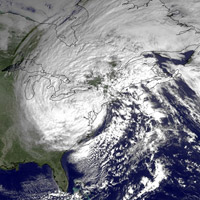
A forecasting firm, IHS Global Insight has indicated the Superstorm Sandy, will likely end up costing $20 billion in damages and anywhere from $10 billion to $30 billion in lost business. Sandy's path has sparked speculation regarding the effect of melting arctic sea ice on weather patterns. Jeff Masters, the co-founder and director of meteorology at Weather Underground, speculated, "There is evidence that Arctic sea ice loss might be responsible..." Masters said. "Our sea ice losses are a relatively new phenomenon, and we don't have a lot of years of data to study. But there certainly is a lot of potential for climate change to affect a storm like this." The potential of climate change to affect weather patterns hit home hard for the millions of people just starting to recover from Sandy's landfall on the Eastern coast of the united States. View November 2, 2012 Huffington Post blog postView November 1, 2012 The New York Times article View October 30, 2012 BBC News article View October 30, 2012 CBC News article View October 30, 2012 Huffington Post article |
|
 Print version Print version |
Top |
| British Columbia Earthquake and Tsunami | 2 November 12 |
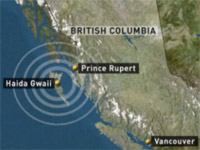
"Not pointing the finger at anybody, but we decided to err on the side of caution and we instigated our response," Schmunk told CBC News. "As it evolved and as it looked like it was of no issue, we're happy to report that it was a good test of our systems and a test of how the community responded to the systems." Tsunami warnings were issued for the West Coast, causing many residents to head for higher ground. A Tsunami warning was issued for Hawaii as waves were predicted to hit around 1:28 am. In the Haida Gawaii Islands, a few days after the earthquake the once famous hot springs that gave their name to Hot Spring Island were discovered all dried up and no longer bubbling with heated waters from below ground. View November 2, 2012 National Post articleView October 29, 2012, October 28, 2012, and October 27, 2012 CBC News articles View October 28, 2012 National Post article Source:
CBC, National Post
|
|
 Print version Print version |
Top |
| Another Omnibus Budget Bill Weakens The Environment | 2 November 12 |

The second 2012 omnibus budget bill, Bill C-45: A second Act to implement certain provisions of the budget tabled in Parliament on March 29, 2012 and other measures was tabled in Canada's Parliament October 18, 2012. Bill C-45 follows Bill C-38: An Act to implement certain provisions of the budget tabled in Parliament on March 29, 2012 and other measures passed by the House of Commons in June 2012. Bill C-38 was a highly controversial omnibus budget bill that became a flashpoint for nation-wide protests and a target of international criticism for pushing through sweeping changes to 70 different pieces of legislation, including landmark environmental laws like the Canadian Environmental Assessment Act and Fisheries Act. Bill C-45, picks up where last spring's budget bill left off. The 457-page omnibus budget implementation bill amends 64 different Acts or regulations. Changes to environmental law, include:
This is the fourth time since 2009 that omnibus budget bills have been used to make changes to Canada's laws, including environmental laws. In addition to the two 2012 Omnibus budget bills the 2010 omnibus budget bill amended the Canadian Environmental Assessment Act to give the Minister of Environment ability to scope environmental reviews to exempt projects from more thorough assessment and to transfer responsibility for certain assessments from the Canadian Environmental Assessment Agency, to weaker bodies such as the National Energy Board; and the 2009 omnibus budget slipped in non-budgetary changes to Canada's Navigable Waters Protection Act. View Bill C-45: A second Act to implement certain provisions of the budget tabled in Parliament on March 29, 2012 and other measuresView October 26, 2012 CBC coverage View October 25, 2012 HuffingtonPost coverage View October 23, 2012 Davis LLP Bill C-45 Introduces Further Changes to Federal Environmental Regulation; Navigable Waters Protection Act to be Overhauled View October 19, 2012 West Coast Environmental Law blog View October 18, 2012 Ecojustice press release View October 2012 Ecojustice backgrounder View October 2012 Miller Thomson Environmental Alert View June 8, 2012, June 1, 2012, and July 21, 2010 Manitoba Wildlands coverage Source:
CBC, Ecojustice
|
|
 Print version Print version |
Top |
| Bipole III Hearings Resume in Winnipeg October 29 | 26 October 12 |
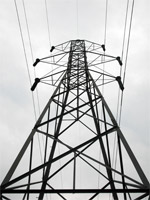
While strong comments are being made about the failure to hold hearings in Swan River, transcripts are now posted for most of the tour. Manitobans who wish to present to the hearings in Winnipeg can contact the CEC to register. There are also notable gaps in Manitoba Hydro's participation in the hearings. The Vice President for Transmission is not available for cross examination. The new project manager is not part of the panel of staff and experts presenting. Undertakings, information requests which Manitoba Hydro agrees to provide, are slow or not being provided. Citizens who wish to observe the hearings are welcome, and providing a spoken presentation to the hearings is based on a request to the secretary of the CEC. View Manitoba Wildlands Manitoba Hydro Projects: BiPole III CEC Hearings pageView Clean Environment Commission Bipole III Hearings page |
|
 Print version Print version |
Top |
| Long Overdue Canada's Boreal Caribou Strategy Released | 26 October 12 |

Prodded by a Federal Court direction in July 2012, the federal government set a tentative date for its improved boreal caribou strategy's release of September 30, 2012. "The habitat protection measures in the strategy only give caribou a 60% chance of long-term survival, which leaves a significant risk that the caribou populations will continue to decline. This falls far short of our recommendation of increasing the target to at least an 80% chance of long-term survival," " said Canadian Parks And Wilderness Society National Conservation Biologist Dr. Chris Miller. The plan finds that 37 of Canada's woodland caribou herds are in decline. Only 14 are self-sustaining. Previous studies have found almost all the Alberta herds — most of which are in the same region as the oilsands — are very unlikely to survive. View October 5, 2012 Recovery Strategy for the Woodland Caribou (Rangifer tarandus caribou), Boreal population, in CanadaView October 15, 2012 Pembina Institute blog View October 5, 2012 Government of Canada press release View October 5, 2012 Canadian Parks and Wilderness Society press release View October 5, 2012 CBC News coverage View October 5, 2012 Prince Albert Now coverage View Mantitoba Wildlands Biodiversity & Species Caribou Strategies page |
|
 Print version Print version |
Top |
| Released : Marine Protected Area Guidelines North America | 26 October 12 |
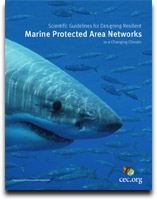
The CEC's practical set of guidelines will help scientists, MPA planners and managers will improve their ability to design, connect, manage, assess and adapt MPAs and MPA networks to potential climate change. In November 2012 the CEC will be publishing a companion piece—a practical guide for MPA managers and network planners on how to implement these guidelines. "We commend the CEC for creating these guidelines. We hope the Government of Manitoba, which has no standards or tools for protected waterways, or water areas will apply them in Manitoba. We need marine protected areas in Hudson Bay based on Manitoba Conservation land & fjord candidates," said Manitoba Wildlands Director Gaile Whelan Enns. View October 23, 2012 Commission of Environmental Cooperation press releaseView July 2012 Commission of Environmental Cooperative report View October 23, 2012 Science Daily coverage Sources:
Commission of Environmental Cooperation
|
|
 Print version Print version |
Top |
| Thousands Defend Coast from Pipelines | 26 October 12 |
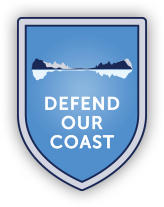
"As Indigenous peoples, we have an obligation to protect our territories for future generations. The vast majority of our peoples do not support the Northern Gateway Pipeline proposal," said BC Assembly of First Nations Regional Chief Jody Wilson-Raybould. The proposed Enbridge Northern Gateway pipeline would carry diluted bitumen from the tar sands of northern Alberta to a proposed tanker port at Kitimat on the central British Columbia (BC) coast. The pipeline will traverse remote, highly valued areas of BC, crossing almost 800 streams, putting valuable environments and species, such as salmon, at risk. Kinder Morgan has proposed a $4.1-billion Trans Mountain project that would expand an existing pipeline from Alberta to Vancouver and bring daily tankers through the already busy Vancouver Harbour. "Our lands and waters are not for sale, full stop," said Chief Jackie Thomas of Saik'uz First Nation. "That is why we are here today standing in solidarity with our allies." Organizations supporting Defend Our Coast events include Indigenous Environment Network, the Yinka Dene Alliance and Coastal First Nations; Council of Canadians, Tanker Free BC, Greenpeace Canada and Occupy Vancouver Environmental Justice; and unions like Communications, Energy and Paperworkers Union, Canadian Auto Workers, the BC Teacher's Federation, Canadian Union of Public Employees-BC and United Fishermen and Allied Workers' Union-CAW. "Canada's iconic coast is far too valuable to risk on tar sands pipelines and tankers and we pledge to defend it," said Maude Barlow, chairperson of the Council of Canadians, a national advocacy group. "We want long-term green jobs that will take us beyond fossil fuels, not short-term high risk pipelines," said Susan Spratt, Western Regional Director of the Canadian Auto Workers. View Defend Our Coast websiteView October 24, 2012, October 22, 2012, and October 18, 2012 CBC News coverage View October 22, 2012 Environmental News Service View October 22, 2012 Yinka Dene Alliancce press release View October 22, 2012 BC Regional Chief Statement on Indigenous Peoples Issues and Resources View October 22, 2012 Greenpeace Feature Story View October 22, 2012 Globe and Mail Op-ed by David Suzuki and Art Sterritt Sources:
Environmental News Service, Yinka Dene Alliance
|
|
 Print version Print version |
Top |
| CEC Bipole III Hearings Continue Travels | 19 October 12 |

Hearings were held in Gillam, Manitoba on October 10 & 11. Julyda Lagimodiere, the Vice President of the Manitoba Metis Federation (MMF) Thompson Region made a presentation on October 10, 2012. Manitoba Hydro provided an overview presentation of the project on the morning of October 11, 2012. This was followed by Manitoba Hydro's presentation on it's trapper compensation policy. Several members from Fox Lake Cree Nation presented on the afternoon of October 11, 2012. This presentation is not yet available on the CEC webpage. Hearings were held in Thompson October 15 & 16, and The Pas October 17 & 18. Updates from hearings in Thompson & The Pas were not yet available as of October 19, 2012. Next CEC hearings move to Dauphin October 22, 2012, Portage October 24, 2012, Niverville October 26, 2012, before returning to Winnipeg October 29th. The tentative end date for hearings in Winnipeg is November 27, 2012. The proposed Manitoba Hydro Bipole III project is a 1400 km 500kV high-voltage DC electrical transmission line originating near the site for the proposed Conawapa & Keeyask generating stations on the Nelson River, terminating east of Winnipeg, east of the Winnipeg Floodway. The Manitoba CEC is conducting public hearing about the potential environmental and socio-economic impacts of constructing and operating this proposed project, as requested by the Minister of Conservation and Water Stewardship. Using information gathered from hearings, the CEC will prepare a report for the minister, with recommendations regarding the project, potential licence standards and other matters. "Visit our Bipole III CEC hearings page for more information, and make sure to bookmark it for updates as the hearings progress," said Manitoba Wildlands Director Gaile Whelan Enns. View Manitoba Wildlands Manitoba Hydro Projects: Bipole III CEC Hearings pageView Manitoba Clean Environment Commission (CEC) Bipole III Hearings page View October 10 & 11, 2012 Transcript of Manitoba Clean Environment Commission (CEC) Bipole III Hearings in Gillam View Manitoba Wildlands Expanded Outline of the December 2011 Bipole III Environmental Impact Statement (EIS) View Manitoba Wildlands BiPole III Clean Environment Commission Chart: Events, Decisions, Documents Sources:
Manitoba Wildlands, Clean Environment Commission
|
|
 Print version Print version |
Top |


 RSS Feeds:
RSS Feeds: